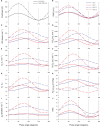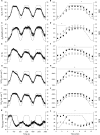Respiratory frequency and tidal volume during exercise: differential control and unbalanced interdependence
- PMID: 30393984
- PMCID: PMC6215760
- DOI: 10.14814/phy2.13908
Respiratory frequency and tidal volume during exercise: differential control and unbalanced interdependence
Abstract
Differentiating between respiratory frequency (fR ) and tidal volume (VT ) may improve our understanding of exercise hyperpnoea because fR and VT seem to be regulated by different inputs. We designed a series of exercise manipulations to improve our understanding of how fR and VT are regulated during exercise. Twelve cyclists performed an incremental test and three randomized experimental sessions in separate visits. In two of the three experimental visits, participants performed a moderate-intensity sinusoidal test followed, after recovery, by a moderate-to-severe-intensity sinusoidal test. These two visits differed in the period of the sinusoid (2 min vs. 8 min). In the third experimental visit, participants performed a trapezoidal test where the workload was self-paced in order to match a predefined trapezoidal template of rating of perceived exertion (RPE). The results collectively reveal that fR changes more with RPE than with workload, gas exchange, VT or the amount of muscle activation. However, fR dissociates from RPE during moderate exercise. Both VT and minute ventilation ( ) showed a similar time course and a large correlation with in all the tests. Nevertheless, was associated more with than with VT because VT seems to adjust continuously on the basis of fR levels to match with . The present findings provide novel insight into the differential control of fR and VT - and their unbalanced interdependence - during exercise. The emerging conceptual framework is expected to guide future research on the mechanisms underlying the long-debated issue of exercise hyperpnoea.
Keywords: Breathing control; exercise hyperpnoea; perceived exertion; sinusoidal exercise; ventilatory pattern.
© 2018 The Authors. Physiological Reports published by Wiley Periodicals, Inc. on behalf of The Physiological Society and the American Physiological Society.
Figures





References
-
- Acevedo, E. O. , Webb H. E., Weldy M. L., Fabianke E. C., Orndorff G. R., and Starks M. A.. 2006. Cardiorespiratory responses of Hi Fit and Low Fit subjects to mental challenge during exercise. Int. J. Sports Med. 27:1013–1022. - PubMed
-
- Bakker, H. K. , Struikenkamp R. S., and De Vries G. A.. 1980. Dynamics of ventilation, heart rate, and gas exchange: sinusoidal and impulse work loads in man. J. Appl. Physiol. 48:289–301. - PubMed
-
- Bell, H. J. , and Duffin J.. 2004. Respiratory response to passive limb movement is suppressed by a cognitive task. J. Appl. Physiol. 97:2112–2120. - PubMed
MeSH terms
LinkOut - more resources
Full Text Sources
Medical

